5 Floating aquatic macrophytes – Others
Water hyacinth, duckweed and Azolla, the most common and important floating macrophytes, have been described in sections 2, 3 and 4. This section covers other miscellaneous floating macrophytes.
5.1 Classification
A list of commonly occurring species is presented in Table 5.1.
Table 5.1
Common and scientific names of some commonly occurring floating aquatic macrophytes Scientific name Family Common names
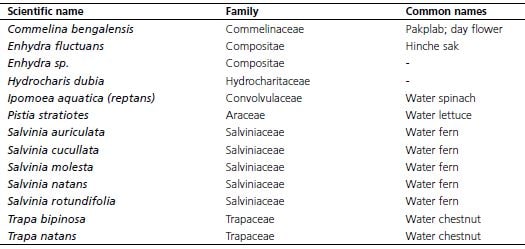
5.2 Characteristics
Like most other macrophytes, these are self-growing plants that are commonly found in the shallow stagnant waters of tropical and sub-tropical countries. The most commonly found are water spinach (Ipomoea), water lettuce (Pistia), water fern (Salvinia spp.) and water chestnut (Trapa spp.).
Water spinach (Ipomoea aquatica) is a floating plant that roots in marshy soil. It is native to India, SE Asia, and S. China and is commonly eaten as a vegetable (Edwards, 1980).
Water lettuce (Pistia stratiotes) is a free-floating aquatic plant that is found growing abundantly in tropical and subtropical region of the world. This plant is very common in lakes, ponds, ditches, irrigation canals, etc. It is reported to be used as a vegetable in India (Varshney and Singh, 1976).
Water fern (Salvinia spp.) is a perennial free-floating aquatic herb belonging to the family Salviniaceae. It has five commonly found species (Table 5.1) and has a wide native range in the neotropics extending from Mexico and the Galapagos Islands through Central America and most of tropical South America as far as southern Brazil (Sculthorpe, 1971). In the Indian sub-continent, the plant was introduced through a route from Brazil to Germany in 1933 (Hadiuzzaman and Khondker, 1993). Reddy and DeBusk (1985) reported the biomass yield of S. rotundifolia to be 32 tonnes DM/ha/year in nutrient non-limiting waters in central Florida, USA. Giant salvinia (Salvinia molesta) is a free-floating clonal fern and reproduces only vegetatively. Though the plant can survive a wide range of temperatures (-3 to 43 ?C), optimal growth occurs at 24 to 28 ?C (Mcintosh, King
Figure 5.1
Water chestnut plants grown in a floodplain, Rangpur, Bangladesh
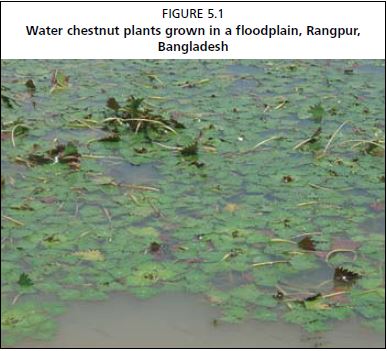
Figure 5.2
Water chestnut fruits harvested from a floodplain, Rangpur, Bangladesh
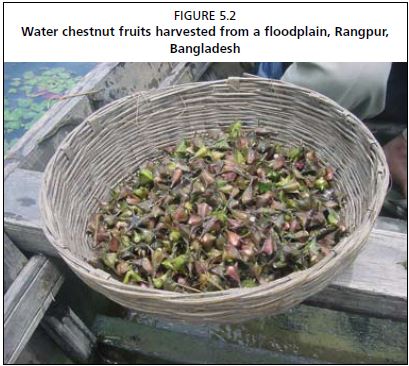
and Fitzsimmons, 2003). Stands of salvinia double in 2.2 days with adequate supply of adequate nutrients. During periods of high growth, leaf size decreases and both leaves and stems fold, doubling and layering to cover more of the water surface. This thick plant growth is harmful for other organisms as it prevents light penetration, reduces gaseous exchange and increases biological oxygen demand.
Water chestnuts (Trapa sp.) (Figures 5.1 and 5.2) are floating annual aquatic plants that grow in slow moving water up to 5 meters deep and are native to warm temperate parts of Asia and Africa.The nut (kernel) of
water chestnuts is eaten by humans in raw or cooked form.
5.3 Production
In South and Southeast Asia, water spinach is often grown for use as a vegetable in India, Bangladesh, Hong Kong (SAR China), Cambodia, Thailand, Indonesia and Viet Nam, sometimes in ponds fertilized with sewage (Figure 5.3). In China, water lettuce has been reported to be cultivated with two other aquatic macrophytes, water hyacinth and alligator weed (Alternathera philoxeroides) (Edwards, 1987). The plants are usually cultivated in rivulets, small bays, or swamps to avoid taking up cultivable land and are usually fed to pigs. Reddy and
DeBusk (1984) reported the biomass yield of water lettuce to be 72 tonnes DM/ha/year in nutrient non-limiting waters in central Florida, USA. Water chestnuts are grown in India, China, Indonesia and Bangladesh.
5.4 Chemical composition
The chemical composition of seven floating aquatic macrophytes is presented in Table 5.2. Of these the moisture content varied between 85-94 percent. Water spinach had the highest crude protein varying between 24-34 percent, higher lipid contents (2.7-3.9 percent) and low ash (~13 percent) and crude fibre (10.2-12.7 percent) contents. The other two macrophytes were moderately rich in crude protein (12-20 percent), high ash (18-26 percent) and crude fibre (12-20 percent) contents. Clearly, water spinach is nutritionally superior to other macrophytes; its crude protein is comparable
Table 5.2
Chemical analyses of some common floating aquatic macrophytes
1 CP = crude protein; EE = ether extract; CF = crude fibre; NFE = nitrogen free extract; Ca = calcium; P = phosphorus
2 Data obtained from Tacon (1987)
3 Adjusted or calculated; not as cited in original publication
Figure 5.3
Production of water spinach from Beung Cheung Ek waste water lake, Phnom Penh, Cambodia
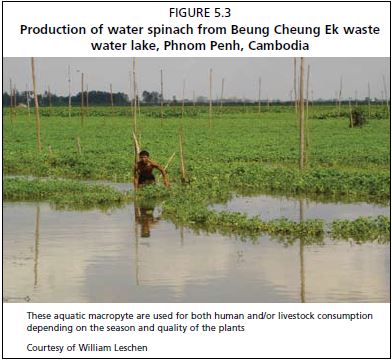
These aquatic macropyte are used for both human and/or livestock consumption depending on the season and quality of the plants
Courtesy of William Leschen
only to duckweed. Some information on the amino acid content of various aquatic macrophytes is contained in Annex 1.
5.5 Use as aquafeed
Little work has been conducted on the use of these miscellaneous floating macrophytes as feed for fish.
A summary of selected experimental studies on the use of dried leaf meal of these macrophytes in pelleted diets for various fish species is presented in Table 5.3. Dried water spinach leaf meal has been evaluated as a dietary ingredient/protein source for milkfish and water lettuce (Figure 5.4) and water fern for grass carp, common carp and rohu. The performance of
test diets containing various inclusion levels of these macrophyte meals were compared with control diets. The latter comprised fishmeal-based pellets, the traditionally used rice bran-oil cake mixture, or a mixture of fishmeal, oil cake and cereal by-products.
Apart from rohu, these floating aquaphyte leaf meals (Table 5.3) produced reasonably good growth (SGR 2.35-3.29 percent) and food conversion (FCR 1.50-2.11). The performances of milkfish, grass carp and common carp fed various test diets were slightly better or comparable to those obtained for the control diets. However, it should be pointed out that Murthy and Devaraj (1991a, 1991b) conducted their feeding trials with grass carp and common
Figure 5.4
A feeding square filled with mixture of grass and chopped water lettuce offered to the fish as supplemental feed (Mymensingh, Bangladesh)
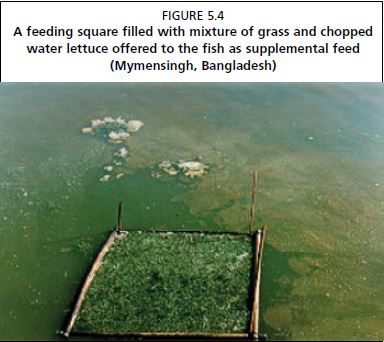
carp in a static experimental setup consisting of a 20 m2 cement cistern. A soil bed of 15 cm was provided to each cistern and an initial manuring of cow dung (15 kg per cistern) was carried out prior to the start of the experiment. These authors recorded the plankton volume fluctuating between 0.007 to 0.041 ml/L in the cisterns, indicating that test fish obtained a part of their nutrition from the plankton. The authors noted that the initial manuring produced the plankton at first but the faecal matter of fish and unconsumed food might have been responsible for the continued plankton production. Borlongan and Colso (1994) obtained an SGR of 3.07 percent for milkfish
fry with water spinach leaf meal in a growth trial conducted in a recirculatory rearing system. However, in this trial, only 15 percent of the total dietary protein (i.e. 6 percent protein in a 40 percent protein diet) was replaced by water spinach leaf meal. For rohu, Ray and Das (1994) obtained very low SGRs (0.50-0.57 percent) with test diets containing various inclusion levels of water fern in a growth trial conducted in an indoor flow-through rearing system (Table 5.3).when compared with a control diet.
Table 5.3
Performance of different fish species to pelleted feeds containing dried floating aquatic macrophytes

1Salvinia molesta
2 Salvinia sp.
Generally, macrophytophagous fish do not consume these floating macrophytes readily in fresh form. Water lettuce is one of the least favoured floating macrophytes for herbivores (Singh et al., 1967). Some scattered reports, however, are available on the consumption of these macrophytes in fresh form. For example, water lettuce is used for feeding Chinese carps in China (Z. Xiaowei, pers. com. 2003). Fresh water lettuce is mashed into liquid form with a high-speed beater and is applied to the pond for carp fingerlings. Alternatively, mashed water lettuce is mixed with rice bran and fermented overnight and applied to the pond. Ling (1967, cited by Edwards, 1987) also reported that water lettuce was chopped into small pieces and used to feed grass carp and common carp in China. The plant was also reported to be processed, either mechanically (soaking, mixing, cutting, or grinding) or biologically. The latter involved green storage and fermentation in ditches, tubs or barrels under anaerobic conditions at 65-75 percent moisture after cutting into 6 cm strips and sealing by a 15 cm layer of dry grass topped by a 15 cm layer of moist soil; if the material was too moist it could be sum-dried or mixed with dry hay before sealing. Another floating macrophyte (Hydrocharis dubia) is considered a good feed for grass carp in China (Z. Xiaowei, pers. com. 2003) and is collected or cultivated for feeding carp fingerlings. In oxbow lakes located in southwestern Bangladesh, water spinach has been found to be one of the preferred macrophytes for grass carp. In the Mymensingh region of Bangladesh, fish farmers often give fresh chopped water lettuce and banana leaves as feed for grass carp and Java barb (Barbonymus gonionotus) in their fish ponds. Both of these herbivores readily consume these macrophytes and good results have been observed.
Preliminary studies by Mcintosh, King and Fitzsimmons (2003) involved feeding three month old (3.5 g) Nile tilapia (Oreochromis niloticus) with live giant salvinia (Salvinia molesta) in a recirculating system, either alone or with a commercial tilapia feed, compared to a control with commercial feed alone. Results indicated that though salvinia was consumed by the fish, there was a weight loss during the 23 day culture period in fish fed salvinia alone. However, some benefit seemed to have been obtained when salvinia was fed in addition to the commercial diet and these authors speculated that a longer feeding period might have demonstrated significant effect. These authors also noted that incorporating dried salvinia as an ingredient in a mixed feed might have produced a more pronounced effect. The primary interest of this research was the use of tilapia in weed control (‘biocontrol’).
Table 5.4
Food conversion ratios (FCR) of selected floating aquatic macrophytes to fish

1 Salvinia molesta
The food conversion values of diets containing varying inclusion of dried water spinach, water lettuce and water fern (S. molesta) tested for various fish species are summarised in Table 5.4. The FCR of water spinach for milkfish was 1.50. However, the inclusion level of water spinach meal was only 23 percent and it remains to be investigated how this might change with increased inclusion levels. The FCR of water lettuce for grass carp and common carp was 1.84 but it varied between 2.00 and 2.66 for rohu, depending on the level of inclusion. The FCR of water fern for grass and common carp was 2.11. For both grass and common carps, the level of inclusion of water lettuce and water fern was 50 percent of the diet.
Table 5.5
Digestibility of selected floating and emergent aquatic macrophytes

1 DM = dry matter; CP = crude protein; EE = ether extract; CF = crude fibre; NFE = nitrogen free extract; GE = gross energy
2 Salvinia cucullata
It is difficult to standardize the FCR values of these floating macrophytes based on the available data. For example, the inclusion level of water spinach meal was only 23 percent in a fishmeal based pelleted diet, while it is apparent that the good FCR values of water lettuce and water fern obtained for grass and common carps were partially obtained because of the plankton produced in the cement cistern. Nevertheless, FCRs of 2.00-2.50 may be reasonably accepted values for dried water lettuce and water fern when these are used at dietary inclusion levels of up to 50 percent.
Digestibility coefficients of water lettuce and water fern are available only for rohu. Water lettuce was well digested by rohu with digestibility coefficients varied between 85.4 and 92.9 percent for crude protein, crude lipid and NFE (Table 5.5). For water fern, crude protein was well digested (91.4 percent) by rohu but the lipid was poorly digested (21.4 percent). The digestibility of NFE was moderately good (66.0 percent).